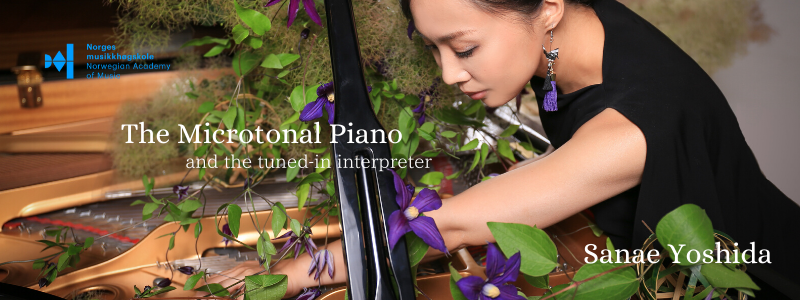30.10.2019
“Schubert møter Helen Keller”
Levinsalen,
Norwegian Academy of Music
I have attached a video from a concert where I perform Bjørn Erik Haugens work “Herzkino” (2019). It’s a work for solo piano, electronics and video. Haugen is questioning both our language and the Western culture 12-tone equal-temperament when he is writing a work for the microtonal piano, drawing inspiration from the blind and deaf Helen Keller, who needed to communicate with the sense of touch, as she had to feel the vibrations and movements of the throat and face.
Though my starting point of the project was very technical/practical, my focus has however changed during the last half year, now focusing more on the concept of minority and some of its implications. (“Musical minority”: I myself am a non-western classically trained pianist playing western contemporary music on the microtonal piano)This, of course leads to minefields of ethics, and the last seminar we had made this even clearer to me.I might not be able to include this as a major part of my 3year research project, but I want to share these thoughts since I find it interesting to view my project from this angle as well.
The standardized way of sharing research is limiting, as we did discuss about in the seminar. It is necessary to have a common language, and the research should be shared, and also refer to others and other research.
And so, a simple but difficult question arises in my mind, as our research model is a result of Western culture, and researchers almost only refer to Western literature, at least within the field of artistic research… What happens to the “minorities” – f.ex the research being written in Japan in Japanese (or other languages), without the funding to let it be translated, etc.? One might find a parallel hierarchy in music, where Western music culture and especially it’s tuning system (12tone equal temperament) has colonized almost the entire planet. Everything (old folk songs, instruments etc) must then be adjusted to the 12TET. Only some few individuals or obscure groups of “nerds” and ideologists will continue to maintain or further develop the their “minority tunings”. Of course, no one thinks this makes the non- western music less valuable. But whenever the minorities are to be researched, they necessarily must be compared with a standard, again the Western standard, in order to articulate how extraordinary they are.I am a Japanese artistic research fellow within a Western system that I deeply admire, and try to learn from. At the same time, I think I might bring something valuable to the project through my experience as Japanese/non-Westerner. I would very much like to raise some awareness both to myself and others about this issue – both about the non-Western and the non-standardized – the minority – through my project.
The process
He is analyzing the speech of Hellen Keller into pitch and rythm, so in the end it will be a “stumfilm” with “talking piano”. As Helen Keller often speaks with a sort of glissando, he asked me if it’s possible to tune one octave in f.ex. a whole-tone interval. So we tried to tune a C4 into G3, so we can go up gradually from there.
Playing only on the key C4.
First with rubber edge between the two strings from the right, and then without rubber edge.
In the film, there were other sound than talking: stumping, throwing things on the floor, closing the door, etc… He suggested me to make all these sounds by doing the same actions as in the film. Then I thought some of the sounds will be interesting to realize with microclusters.
By ear, we’ve tried to find the sound of throwing a silver spoon on the floor. The pitch was close to the highest G, but not completely, so I tuned down one of the strings in the course. It got more overtones and sounded much closer to the original sound.
All three strings. Only the left string is tuned down 240 cent. G to 40 cent lower F.
Only the left string. 40 cent lower F.
Reflection
Det mikrotonale hadde for meg både en Klanglig, konseptuell og en verdi ved at man lager en skala til et stykke som kanskje aldri har vært laget og hørt før. Det var viktig å ikke bruke fulltemperert siden personen skalaen og stykket er basert på ikke er formatert innen denne skalaen siden hun ikke har hørt den. ( Det er ikke helt presist siden hun ble døv når hun var spedbarn…. ) Jeg prøvde å utvide pianoets klang gjennom at vi sjekket hvor mange toner vi kunne legge til i en oktav, som jeg mener å huska var tre. Her styrte instrumentets bergrensning, hadde det gått med 145 ekstra toner innen en oktav, så hadde jeg brukt det. Det kunne vært interessant å presentere en rent lydlig versjon, jeg tror det fungerer best med video og, men det kan fungere.
18.11.2019 Bjørn Erik Haugen
This project led me to look at microtonality from different angles, also from several ethical point of views. I felt the weight was quite much on the conceptual side, and when considering the timbre f.ex. of Helen Keller’s voice, there were few possibilities to research as a performer. What I could do, was to listen to Keller’s speech and imitate the voice only with dynamics and some subtle piano timbre differences. When I watched the video recording from the concert after all, I thought that the music itself is quite monotone. One could argue that the film and Keller’s speeches are monotone too, but still the sound palette was relatively poor. I’m hoping to work with the composer again, to see if it is possible to make the work even stronger by varying the piano sound more; so that I am not only performing a pitch analysis.

